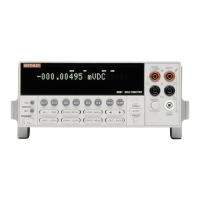IEEE-488 Reference
4-181
Query :PTRansition? Query PTR register
Short-form formats: :stat:meas:ptr?
:stat:ques:ptr?
:stat:oper:ptr?
:stat:oper:trig:ptr?
:stat:oper:arm:ptr?
:stat:oper:arm:seq:ptr?
Response message: Decimal value (see Note)
Note: The binary equivalent of this decimal value indicates which bits in the register are set. For
example, for an acquired decimal value of 516, the binary equivalent is 0000001000000100. For
this binary value, bits B9 and B2 are set.
Description These commands are used to program the positive transition (PTR) registers. A positive
transition is defined as a 0 to 1 state change in the condition register. Thus, when an event is
programmed for a positive transition, the appropriate bit in the corresponding event register will
set when the corresponding bit in the condition register changes from 0 to 1. For example, if bit
B9 of the Positive Transition Register of the Measurement Transition Filter is set, then the buffer
full event is programmed for a positive transition. The BFL bit (B9) in the Measurement Event
Register will set when the trace buffer becomes full. For details on register structure, see
paragraph 4.6.
The PTR registers are shown in Figures 4-34A through 4-39A. Included is the decimal weight
of each bit. The sum of the decimal weights of the bits that you wish to set is the parameter
(<NRf>) that is sent with the command. For example, to program RAV (B5) and BFL (B9)
measurement events for positive transitions, send the following command:
:stat:meas:ptr 544
where; BFL (bit B9 = Decimal 512
RAV (bit B5) = Decimal 32
<NRf> = 544

